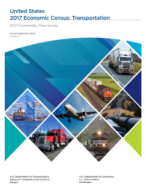Transportation-Commodity Flow Survey: United States: 2017
Transportation-Commodity Flow Survey: United States: 2017
General
The Commodity Flow Survey (CFS) is a joint effort by the Bureau of Transportation Statistics (BTS) and the U.S. Census Bureau, U.S. Department of Commerce. The survey is the primary source of national and state-level data on domestic freight shipments by establishments in mining, manufacturing, wholesale, auxiliaries, and selected retail and services trade industries located in the 50 states and the District of Columbia. Data are provided on the type, origin and destination, value, weight, modes of transportation, distance shipped, and ton-miles of commodities shipped. The CFS is conducted every 5 years as part of the economic census. It provides a modal picture of national freight flows and represents the only publicly available source of commodity flow data for the highway mode. The CFS was conducted in 1993, 1997, 2002, 2007, 2012, and most recently in 2017.
The CFS assesses the demand for transportation facilities and services, energy use, and safety risk and environmental concerns. CFS data are used by policy makers and transportation planners in various federal, state, and local agencies. Additionally, business owners, private researchers, and analysts use the CFS data for analyzing trends in the movement of goods, mapping spatial patterns of commodity and vehicle flows, forecasting demands for the movement of goods, and determining needs for associated infrastructure and equipment.
The CFS publication provides data by shipment characteristics of commodities transported in the U.S. The publication data series include the geographic area series, temperature control series, exports series, and hazardous materials series.
Exports Shipments
An export in the CFS is defined as shipment to a foreign country from the 50 states and Washington, DC. Shipments to U.S. possessions and territories are also treated as exports. Respondents to the CFS were asked to report the foreign city, country of destination, and mode of transport by which the shipment left the country. We also asked the respondent to report the U.S. port, airport, or border crossing of exit and report the “domestic mode” of transport used to reach the U.S. destination. Due to the exclusion of industries outside the scope of the CFS (see Industry Coverage), these data are not directly comparable to the 2017 merchandise trade exports published by the Department of Commerce.
Shipment characteristics including value, tons, and ton-miles are presented in summary form in this report. Ton-miles, which is defined as the shipment weight multiplied by the mileage traveled by the shipment, uses domestic mileage only for the calculation.
Hazardous Materials Shipments
The U.S. Department of Transportation defines hazardous materials as belonging to one of the nine hazard classes, as shown below.
Hazardous Material Classes:
Class 1—Explosives
Class 2—Gases
Class 3—Flammable Liquids
Class 4—Flammable Solids
Class 5—Oxidizing Substances and Organic Peroxides
Class 6—Toxic Substances and Infectious Substances
Class 7—Radioactive Materials
Class 8—Corrosive Substances
Class 9—Miscellaneous Hazardous Materials
As part of the shipment characteristics collected in the 2017 CFS, we asked respondents to provide the four-digit United Nations (UN) or North American (NA) identification number. For the 2017 CFS data, we used the UN/NA code to: (1) identify the shipment as hazardous material, and (2) assign the shipment to one of the nine hazardous material classes for purposes of producing summary tabulations.
The data from the 2017 CFS for hazardous material shipments are aggregated to these nine classes, as well as their subcategories known as divisions. Data are also shown for selected UN/NA codes.
For the 2017 CFS, 26 Standard Classification of Transported Goods (SCTG) codes were identified as always being hazardous materials. Even if the respondent left the UN/NA code blank, we assigned the shipment to the appropriate UN/NA code. For example, every shipment of gasoline (SCTG 17110) was assigned a UN/NA code of 1203 either by the respondent or during our tabulation process. When an SCTG could have translated to more than one UN/NA code, the shipment was reviewed and the appropriate UN/NA code was chosen.
Please note that because of the industry coverage and shipment definitions of the CFS, certain hazardous materials such as infectious substances or radioactive wastes were not well represented in the CFS data.
The UN classification system has been adopted for worldwide use by the United Nations Committee of Experts on the Transport of Dangerous Goods. The UN system was incorporated into the Federal Code of Regulations by the U.S. Department of Transportation for domestic transportation in 1980. The NA system is a parallel hazard identification system used in North America when transporting hazardous materials that are not assigned a UN number or when transporting under specific North American exceptions. For additional information about the UN or NA codes, please refer to Title 49, Code of Federal Regulations, Part 172.101.




